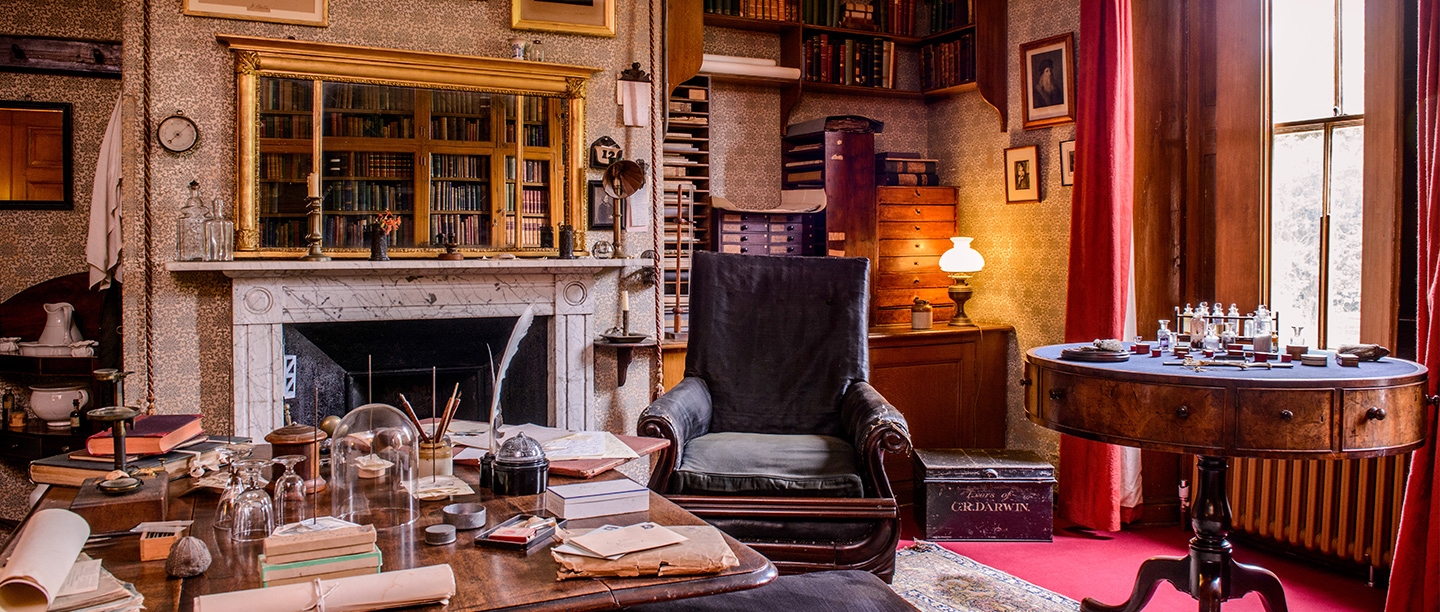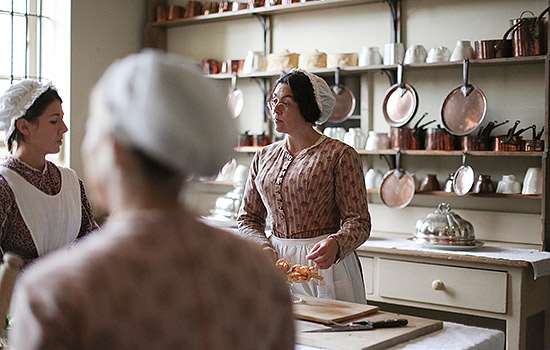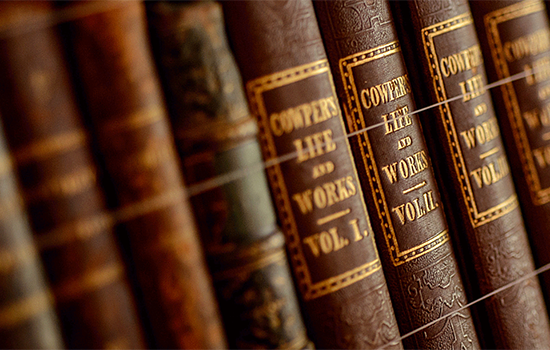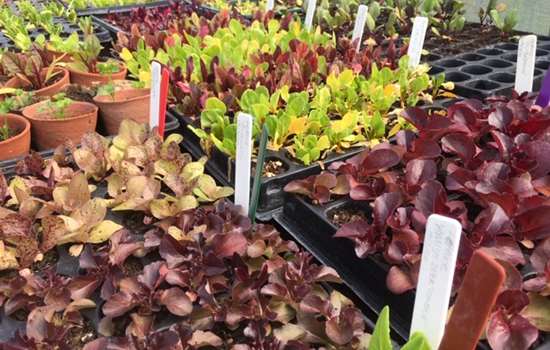
Upon returning to England in 1836, five years after the HMS Beagle had set sail, Charles Darwin dedicated his life to making sense of the extraordinary things he had seen. While this meant endless hours spent writing up his discoveries, it also involved a series of adventures that would absorb Darwin until his death in 1882. They were, in many respects, every bit as remarkable as his explorations of the Keeling, Falkland and Galapagos Islands. The main difference was that they occurred much closer to home. They were Darwin’s great experiments, and once they began to produce results, the world would never be the same again.
From September 1842, closer to home meant Down House in Kent, a place in the country better suited to Darwin’s growing family than his town house in London. Darwin described Down as ‘ugly’ and ‘neither old nor new’ in a letter to his sister, but in fact it was a classic fixer-upper, and Charles and his wife Emma would go on to redevelop every aspect of the site.
Down is an unconventional exercise in Victorian renovation, however. For pretty much every act of Darwinian DIY was inspired less by aesthetics or domestic requirements than it was by experimentation. Down and its gardens were one of Victorian England’s great private laboratories. They provided the setting and materials – and sometimes even a keen team of lab assistants – for some of the most illuminating scientific experiments ever conducted. This makes Down a special place to visit – but it also means it’s surprisingly possible to replicate many of Darwin’s experiments in one’s own home and garden, with everyday household objects and plants.
In other words, perhaps more than any other scientist, it’s not at all difficult to experiment like Darwin. Here’s how...
1. Do… Home Improvement
Fitting a new kitchen? Leave room for test-tubes and pigeon-boiling. Building a new conservatory? Make sure it’s designed with your collection of insectivorous plants in mind.
Charles Darwin was a devotee of DIY, so long as his home improvements would also assist his experiments. Soon after they moved into Down, Charles and Emma planted a kitchen garden – but it wasn’t long before Charles took over a corner for his ‘experimental beds’. Then he started work on a hothouse next to the greenhouse, to provide the specialised growing environment he needed for his collection of rare plants.
Darwin’s greenhouse, filled with carnivorous plants
2. Don’t… Be Squeamish
If you didn’t enjoy cutting up frogs at school, or you’re scared of mice, that sort of thing, experimenting like Darwin might not be a good idea.
Darwin’s dedication to his work meant he was able to focus on the end when the means were, frankly, pretty gross. Whether it was boiling up pigeons in his kitchen, feeding toenail clippings to sundew plants, or stuffing dead sparrows with oats and giving them to birds of prey, to track the progress of seeds through different digestive systems, our hero did things that it’s probably best to avoid trying at home.
Darwin’s collection of beetles, on display at Down House
3. Do… Show and Tell at Dinner Parties
‘Guests’ coming round for supper? Are you sure you don’t mean ‘focus groups’?
Darwin liked to entertain visitors with a sequence of ‘ghoulish’ photographs showing a man having his face prodded with electrical current in various different places. He would then ask them to describe the emotion depicted in each image, hoping to determine a set of universal core emotions for his book, The Expression of the Emotions in Man and Animals. The University of Cambridge recently re-created this sinister study, so you’d be in good company if you did the same.
The University of Cambridge recreated Darwin’s experiment on the expression of emotion. © University of Cambridge
4. Don’t… Kill the Weeds in Your Garden
What do you mean you’ve just invested in a value pack of weed-killer? Weeds are brilliant! Herbicide might as well be renamed ‘Experimenticide’.
For Darwin, weeds represented experimental opportunities. He sectioned off a rectangle of the Down House lawn and carefully noted what weeds grew and how certain species predominated. This microcosmic arena fed into some of his most radical thinking about the struggle for existence and his theory of evolution. It has been recreated in the present-day gardens at Down House.
Recreation of Darwin’s ‘lawn experiment’ at Down House
5. Do… Make Use of What You’ve Got
Paradigm-shifting experiments don’t automatically require expensive equipment and staff. A surprising amount can be achieved with what one already has lying around, whether that be flowers or children.
Darwin was a master of utilising the ordinary to achieve the extraordinary. He used a neighbour’s orchid collection the family had acquired as a fashionable hobby, to make sense of the relationship between evolution and pollination. And he employed his children to chase bees he’d dusted with flour, in order to track their flight paths.
Darwin with his eldest son William
6. Don’t… Stop at 10 or Even 20 Variations
Next time you tell somebody that variety is the spice of life, remember that there are over 350 spices in the world.
When Darwin bred gooseberries, he didn’t stop until he’d grown 54 different varieties. When he turned pigeon fancier, he continued to breed and acquire variant specimens until he had a collection of 120. When testing the survival of seeds in different conditions, he didn’t just use salt water, sand, hot water and sunshine; he also experimented with excrement, simulated gastric juices and a smear of mud on a duck’s foot.
Glass jars and pill boxes used for specimens on Darwin’s desk
7. Do… Crowdsource
Labouring under the misapprehension that Kickstarter invented crowdsourcing? In this, as in so many things, Darwin was 150 years ahead of you.
In addition to his constant experimentation, Darwin was a prolific letter-writer – indeed, his study at Down reflects a life spent writing alongside laboratory work. Through his network of epistolary contacts, he facilitated a steady stream of deliveries that made the scope of his work possible: rare orchids, obscure pigeon breeds, and a splendid array of animal carcases at various stages of decomposition.
Darwin’s desk at Down House
8. Don’t… Rush
The instant gratification demanded by millenials just isn’t the Darwin way.
Darwin wanted to improve his hay crop and was advised to spread chalk and cinders over mossy patches. He decided to make an experiment out of it. Having recorded each location, he revisited these patches … wait for it … 29 years later! The chalk and cinder had sunk to a depth of around seven inches. Darwin began to wonder whether earthworms might be responsible, and duly built the worm stone one can still see at Down today – to further test that notion.
Skull of a primate, collected by Darwin
9. Do… Follow a Routine
‘All truly great thoughts are conceived while walking,’ observed Nietzsche. But why bother with a different route each day?
Darwin’s ‘sandwalk’, just beyond the walls of his vegetable garden, is where he walked every single day until the final weeks of his life. It was a place for meditation, known as his ‘thinking path’, and as he made a complete circuit he would place a flint in the path to help him remember how many times he’d been round. His children would often hide in the bushes and add or remove flints to mess with his routine. And that’s why Nietzsche never had children.
Darwin’s ‘Sandwalk’ at Down House, where he walked every day
10. Don’t… Publish Prematurely
Deadlines are meant to be broken. There is no such thing as too much background research. Step away from the blog. What do you mean, that’s an ironic sentiment to conclude a blog post with?
22 years after the Beagle returned to England, Darwin finally facilitated the chain of events that would result in the publication of On the Origin of Species in November 1859 – and only then because he was suddenly made aware that Alfred Russel Wallace had independently reached similar conclusions. Darwin didn’t like to publish until every facet of his argument was perfectly in place, every leap of logic perfectly watertight. He would even prepare, in advance, counter-arguments addressing the criticisms he knew he would receive upon publication. His meticulous patience is one of the main reasons why so much of his work remains relevant to scientific practice today.
Want to find out more?
Read further research about Darwin at Down House
Discover more about the gardens at Down House
Read a story about the Darwin children.
Postcard from Darwin to Wallace
More to explore
-

Below Stairs at Audley End
What were Victorian servants’ lives really like? Discover the stories of the men, women and children who worked at Audley End House in the 1880s.
-

Places with Literary Links
If you're a book-lover, artist, or poet, our guide to sites with links to English literature should give you plenty of inspiration.
-

Gardening Tips
Taking tips from the past, here are our historic gardeners' top tips for protecting your plants and produce at home.